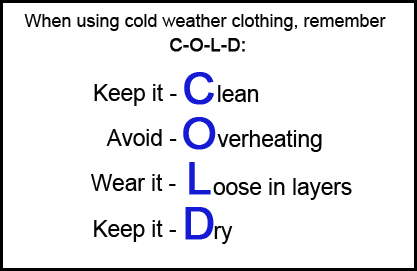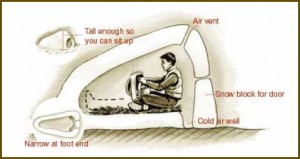
In cold climates, you cannot survive outdoors without shelter or fire. Water may not be a concern because of heavy snows and you can survive weeks without food. In frigid temperatures, your survival is measured in hours, without adequate shelter. Clothing can be considered shelter, as well as a tree or heavy foliage that breaks the wind. However, these are temporary measures and would not be considered adequate shelters to survive the night in cold temperatures.
Hypothermia is a medical condition and it occurs when your core body temperature is lowered by three degrees down to 95ᵒF/35ᵒC. Hypothermia is fatal if not treated.
Clothing is important, and the right clothing can make a difference. Wool is the best cold weather insulator because even when wet it will retain up to 80 percent of its insulating qualities. Wear wool next to your skin to wick moisture away from your body. Your body cools itself by evaporation of sweat. If you perspire from exertion in cold temperatures, the evaporation of the moisture will cool your body. It is important you know how to regulate your body temperature by layering your clothes to prevent sweating. However, if you do sweat and you are wearing wool it will wick the moisture away preventing evaporation from cooling your body. Your outermost layer should be a waterproof coat or poncho. Next is a layer that can keep you warm if you remove the outer layer. Next to your skin should be wool or real fleece.
Your neck, wrists and thighs must be protected from the cold. Large blood vessels are located in these areas that carry warm blood to help warm your extremities. Cold air can chill the blood in the vessels if they are exposed. Keep your head covered to prevent heat loss. Heat always conducts from warm to cold so your objective is to keep your body heat contained next to your body by the proper clothing and shelter.
Thermal heat blankets will reflect radiate heat back onto your body so always have at least two with you.
Shelter

Snow Cave Shelter
Shelter in deep snow can be the snow itself. You can pile snow close to a windbreak such as a rock wall or even certain trees. You can also excavate a snow cave and crawl inside. If you are in a clearing and the snow is not deep enough for a cave, or you do not want one, you can build walls and lay your poncho or thermal blanket over the top. Dig down to bare ground, and pile the snow up along the sides and build your fire so it can reflect off the covering on to you inside. The inside of a snow cave be as much as 20 degrees warmer than the outside air even without a fire. If you do have a fire, build it so the heat is reflected inside. Make sure you have an air hole inside the cave to release moisture and smoke. Allow the snow to settle for 30 minutes before entering your snow cave.
Essentials You Should Have to Survive Outdoors In Frigid Temperatures
- Proper clothing in layers
- Axe/Machete/Folding Wood Saw
- Quality rope and consider 550 Para Cord cold weather will not affect its flexibility
- Multi-Tool
- Fixed Bladed Knife
- Folding entrenching tool
- 20-24 gauge wire for snares, shelter building, gear repair or general binding
- First Aid Kit
and consider including a Suture Kit
for closing wounds
- 15-20 pound fishing line with assorted hooks and tackle
- Sewing Kit
for clothing and gear repair and for wound closure
- Fire starting materials such as a magnesium stick
and Ferro Rod
have dry tinder with you because wood may be damp or wet in snowy regions.
- Shelter such as a nylon tent, poncho
or tarp
- Two high quality thermal blankets once can be used as a shelter and the other to wrap yourself in
- High protein foods ready to eat
- Drinking water and remember your thirst trigger will not work in cold weather so you must drink water even if you do not have thirst. Your body will lose fluids by breathing which is evident by the fact you can see your breath, which is evaporated body fluids, and by urination and digestion of foods.
- A collection vessel to melt snow in or boil surface water for purification
- Water purification tablets
- Two stainless steel canteens
It is assumed you would have your cold weather gear on your body. Carry extra socks and change often because they will become damp from your feet sweating it is important you keep your feet dry. Avoid sleeping with your socks on if you have a sleeping bag because your socks will be damp and that will chill your feet. Your objective is to prevent sweating by layering clothes and building an adequate shelter and getting a fire started.

0 comments:
Post a Comment